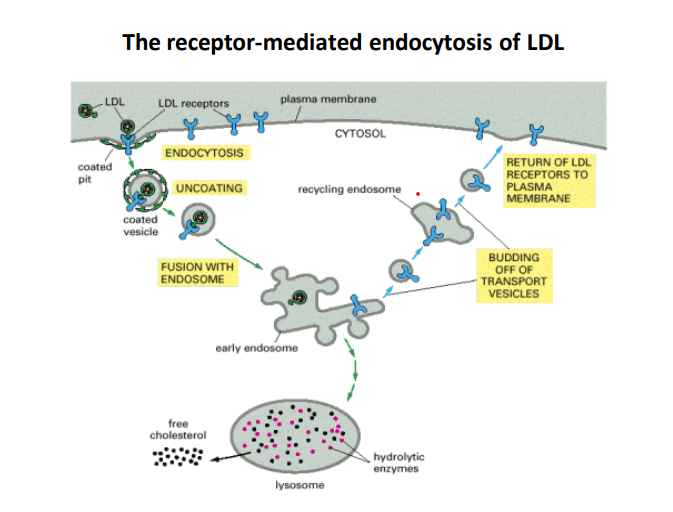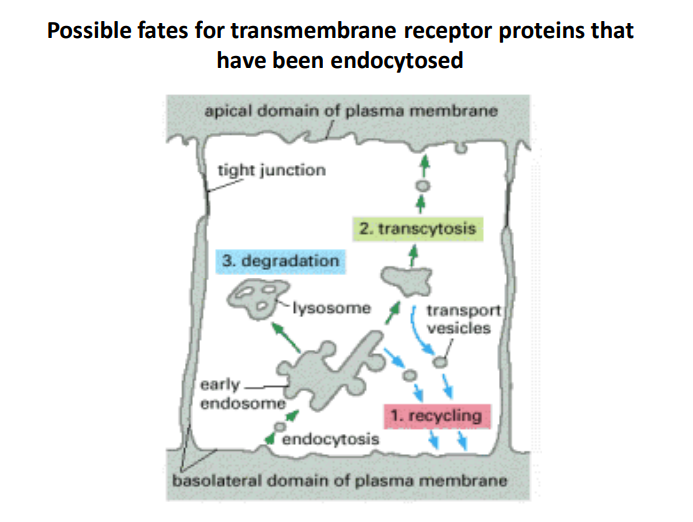Receptor-Mediated Endocytosis of LDL: A Breakdown
The Receptor-Mediated Endocytosis of LDL

-
LDL and LDL Receptors
- Description: Low-Density Lipoprotein (LDL) is a type of cholesterol that circulates in the blood. LDL receptors on cell surfaces specifically bind to LDL particles.
- Thoughts: Understanding the role of LDL is crucial since its uptake is essential for maintaining cholesterol homeostasis in cells. High levels of LDL are associated with cardiovascular diseases.
-
Endocytosis
- Description: This process involves the internalization of LDL by the cell. The specialized area of the membrane where this occurs is called a coated pit.
- Thoughts: Endocytosis allows cells to regulate nutrient uptake and maintain proper cellular function. It is essential for cellular communication and response to external signals.
-
Coated Vesicle Formation
- Description: After LDL binds to its receptor, the coated pit invaginates and forms a vesicle around the LDL particle.
- Thoughts: The presence of a protein coat on the vesicle is crucial for its stability and for directing the vesicle to the appropriate intracellular compartments.
-
Uncoating
- Description: Once inside the cell, the vesicle loses its protein coat to expose its contents.
- Thoughts: The uncoating step is vital for the subsequent fusion of the vesicle with endosomes, allowing the transport of LDL to intracellular destinations.
-
Fusion with Endosome
- Description: The coated vesicle fuses with early endosomes, where the processing of LDL begins.
- Thoughts: This fusion is critical for maintaining the proper pH and environment necessary for enzymatic activity and sorting of endocytosed materials.
-
Recycling of LDL Receptors
- Description: After LDL processing, LDL receptors can be recycled back to the plasma membrane for reuse.
- Thoughts: Recycling is an energy-efficient mechanism that allows cells to utilize receptors multiple times, which is essential for maintaining receptor availability and effective LDL uptake.
-
Transport Vesicles Budding off
- Description: Transport vesicles containing processed materials bud off from the late endosomes.
- Thoughts: This is part of the cellular sorting mechanism, directing materials either to lysosomes for degradation or back to the cytoplasm for utilization.
-
Free Cholesterol and Hydrolytic Enzymes
- Description: The lysosome contains hydrolytic enzymes that break down LDL to release free cholesterol for cellular use.
- Thoughts: Regulation of cholesterol levels is critical. Excess cholesterol can lead to dysfunction and disease, so lysosomes play a key role in cellular cholesterol metabolism.
| Component | Description |
|---|---|
| LDL | Low-Density Lipoprotein, involved in cholesterol transport |
| LDL Receptors | Proteins that bind and mediate the uptake of LDL |
| Endocytosis | Cellular process of internalizing substances |
| Coated Vesicle | Vesicle that forms from a coated pit during endocytosis |
| Uncoating | Process of losing the protein coat from the vesicle |
| Early Endosome | Organelle where initial processing of endocytosed LDL happens |
| Recycling of Receptors | Process of returning receptors to the plasma membrane |
| Hydrolytic Enzymes | Enzymes in lysosomes that break down materials, including LDL |
Extended readings:
pmc.ncbi.nlm.nih.gov
Approaches to Visualising Endocytosis of LDL-Related Lipoproteins
www.sciencedirect.com
Receptor-Mediated Endocytosis - an overview | ScienceDirect Topics
pubmed.ncbi.nlm.nih.gov
Receptor-mediated endocytosis and the cellular uptake of ... - PubMed
Possible Fates for Transmembrane Receptor Proteins After Endocytosis

-
Endocytosis
- Thoughts: This is the process by which cells internalize substances from their external environment. Receptor proteins at the apical domain of the plasma membrane are engaged during this process.
- Additional Information: Endocytosis can involve various mechanisms, such as receptor-mediated endocytosis, where specific receptors on the cell membrane bind to ligands, triggering vesicle formation.
-
Transcytosis
- Thoughts: This process allows for the transport of receptors across the cell from one membrane domain to another.
- Additional Information: Transcytosis is particularly important in polarized cells, such as epithelial cells, where substances need to move from the apical to the basolateral side without entering the general cytoplasm.
-
Recycling
- Thoughts: Recycled receptors can be returned to the plasma membrane, maintaining the cell's ability to respond to extracellular signals.
- Additional Information: Recycling is crucial for re-establishing cellular receptor populations and is a key mechanism for regulating signaling pathways. It prevents the loss of receptors and ensures that cells can continually sense their environment.
-
Degradation
- Thoughts: Some receptors are directed to lysosomes for degradation, a process that helps regulate receptor levels and signaling pathways within the cell.
- Additional Information: This pathway is essential for maintaining homeostasis and removing damaged or unneeded receptor proteins. Accumulation of undegraded receptors can lead to cellular dysfunction.
| Fate | Process Description |
|---|---|
| 1. Recycling | Receptors return to the plasma membrane for reuse. |
| 2. Transcytosis | Transport of receptors across the cell from apical to basolateral domain. |
| 3. Degradation | Receptors sent to lysosomes for breakdown and removal. |
- Note on Membrane Domains: The diagram highlights the apical and basolateral domains of the plasma membrane, underscoring the polarized nature of certain cells (e.g., epithelial cells) and their specialized functions in transporting molecules.
Extended readings:
pmc.ncbi.nlm.nih.gov
The Endosomal Recycling Pathway—At the Crossroads of the Cell
pmc.ncbi.nlm.nih.gov
Polarity and Endocytosis: Reciprocal Regulation - PMC
www.sciencedirect.com
Transcytosis - an overview | ScienceDirect Topics